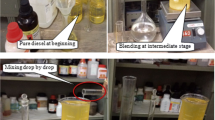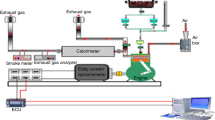Abstract
Diesel engines are playing a vital responsibility in the field of automobile, agriculture, construction, and power generation. In the present world, much research is going on in the field of renewable energy to replace conventional sources of energy. But it is not very easy to replace diesel engines with other sources due to the better power output and reliability. The emissions from CI engines are very harmful for human health and for the environment. The major emissions are smoke and NOx which need to be controlled in an effective manner. In this work, direct injection variable compression ratio CI engine was used in experimental investigations for determining the combustion characteristics for D–MXEE–NM blends at different compression ratios. By performance analysis and exhaust emission of engine at peak load, D–MXEE5–NM2.5 (diesel 92.5%, 2–methoxyethyl ether 5%, and nitromethane 2.5%) blend was identified as best blend among all tested fuel blends and pure diesel at normal compression ratio (17.5). Further, all considered fuels with different CR values at peak load were ranked by Entropy–VIKOR method. From the analysis, D–MXEE5–NM2.5 at CR 19.5 was found as best fuel blend (ranked first) among all fuel blends and different compression ratios considered with same experimental conditions. By comparison of best fuel blend D–MXEE5–NM2.5 (at advanced compression ratio 19.5) with diesel (at standard CR 17.5), emission decline (HC 66.66%, CO 70.00%, and smoke 16.09%) and performance improvement (decrement in BSFC 7.07% and increment in BTE 4.41%) were obtained significantly at peak load. However, negligible increment in NOx (3.58%) was observed.









Similar content being viewed by others
Data availability
All data generated or analyzed during this study are included in this published article.
Abbreviations
- D:
-
Diesel
- CA:
-
Crank angle
- CI:
-
Compression ignition
- CO2 :
-
Carbon dioxide
- CO:
-
Carbon monoxide
- CR:
-
Compression ratio
- DI:
-
Direct injection
- HC:
-
Hydrocarbons
- IC:
-
Internal combustion
- IP:
-
Injection pressure
- IT:
-
Injection timing
- NM:
-
Nitromethane
- NOx:
-
Nitrogen oxides
- PM:
-
Particulate matter
- AHP:
-
Analytic hierarchy process
- ANP:
-
Analytic network process
- BTE:
-
Brake thermal efficiency
- EGR:
-
Exhaust gas recirculation
- GRA:
-
Grey relational analysis
- HDT:
-
Hasse diagram technique
- rpm:
-
Revolution per minutes
- VCR:
-
Variable compression ratio
- btdc:
-
Before top dead center
- BSFC:
-
Brake-specific fuel consumption
- FAHP:
-
Fuzzy analytical hierarchy process
- MCDM:
-
Multi-criteria decision-making
- MXEE:
-
2–methoxyethyl ether
- TOPSIS:
-
Technique for order preference by similarity to ideal solution
- VIKOR:
-
Vlse Kriterijumska Optimizacija Kompromisno Resenje
- ELECTRE:
-
Elimination et choix traduisant la realite
- v/v:
-
Volume by volume
References
Ambekar A, Bhangale R, Chatterjee R, Kulkarni C, Kumar S, Chowdhury A (2015) Glow-plug-assisted combustion of nitromethane sprays in a constant volume chamber. Appl Therm Eng 76:462–474
Banapurmath NR, Khandal SV, Ranganatha Swamy L, Chandrashekar TK (2015) Alcohol (ethanol and diethyl ethyl ether)–diesel blended fuels for diesel engine applications–a feasible solution. Adv Automob Eng 4(1):117
Baskar P, Nanthagopal K, Elango T (2011) The effect of two oxygenates on diesel engine emissions. ARPN J Eng Appl Sci 6(3):55–60
Conti JJ, Holtberg PD, Diefenderfer JR, Napolitano SA (2015) Annual energy outlook with the projections of 2040, U.S. Energy Information Administration, U.S. Department of Energy, Washington DC 20585
Coyle ED, Simmons RA (2014) Understanding the global energy crisis. Purdue University Press e–books
Damaneh MS (2011) An optimization modelling for string selection in molecular biology using Pareto optimality. Appl Math Model 35(8):3887–3892
Di Y, Cheung CS, Huang Z (2010) Experimental investigation of particulate emissions from a diesel engine fueled with ultralow-sulfur diesel fuel blended with diglyme. Atmos Environ 44:55–63
Dubey P, Gupta R (2018) Influences of dual bio–fuel (Jatropha biodiesel and turpentine oil) on single cylinder variable compression ratio diesel engine. Renew Energy 115:1294–1302
Giakoumis EG, Rakopoulos CD, Dimaratos AM, Rakopoulos DC (2013) Exhaust emissions with ethanol or n-butanol diesel fuel blends during transient operation : a review. Renew Sust Energ Rev 17:170–190
Hoseinpour M, Sadrnia H, Tabasizadeh M, Ghobadian B (2018) Evaluation of the effect of gasoline fumigation on performance and emission characteristics of a diesel engine fueled with B20 using an experimental investigation and TOPSIS method. Fuel 223:277–285
Khalife E, Tabatabaei B, Demirbas A, Aghbashlo M (2017) Impacts of additives on performance and emission characteristics of diesel engines during steady state operation. Progress Energy Combust Sci 59:32–78
Kumar C, Rana KB, Tripathi B, Nayyar A (2018a) A comparative study of oxygenated additives for diesel in compression ignition engine. Int J Renew Energy Technol 9:16–27
Kumar C, Rana KB, Tripathi B, Gupta P (2018b) Combustion characteristics of methanol blended diesel fuel in CI engine. Int J Pharm Sci Rev Res 50:101–104
Kumar C, Rana KB, Tripathi B (2019) Effect of diesel-methanol-nitromethane blends combustion on VCR stationary CI engine performance and exhaust emissions. Environ Sci Pollut Res 26(7):6517–6531
Kumar C, Rana KB, Tripathi B (2020) Effect of ternary fuel blends on performance and emission characteristics of stationary VCR diesel engine. In: Energy Sources, Part A: Recovery, Utilization, and Environmental Effects, pp 1–20
Moghaddam MS, Moghaddam AZ (2014) Performance and exhaust emission characteristics of a CI engine fueled with diesel–nitrogenated additives. Chem Eng Res Des 92(4):720–726
Nayyar A, Sharma D, Soni SL, Mathur A (2017) Experimental investigation of performance and emissions of a VCR diesel engine fuelled with n–butanol diesel blends under varying engine parameters. Environ Sci Pollut Res 24:20315–20329
Nayyar A, Sharma D, Soni SL, Gautam V, Kumar C, Augustine M (2019) Study of performance and emissions of a stationary DI variable compression ratio CI engine fueled with n-butanol/diesel blends using Taguchi technique: analytical and experimental analysis. In: Energy Sources, Part A: Recovery, Utilization, and Environmental Effects, pp 1–27
Ommi M, Nekofar K (2009) Emission and properties characteristics using additive–ethanol–diesel fuel blends on a diesel. J Eng Ann Fac Eng Hunedoara 7(2):35–42
Perimenis A, Walimwipi H, Zinoviev S, Miertus S (2011) Development of a decision support tool for the assessment of biofuels. Energy Policy 39(3):1782–1793
Pirouzfar V, Zarringhalam A, Mirza B (2012) Physicochemical properties and combustion performance of gas oil-fuel additives. J Energy Resour Technol 134(4):1–7
Rassafi AA, Vaziri M, Azadani AN (2006) Strategies for utilizing alternative fuels by Iranian passenger cars. Int J Environ Sci Technol 3(1):59–68
Sakthivel G, Ilangkumaran M, Nagarajan G, Shanmugam P (2013) Selection of best biodiesel blend for IC engines: an integrated approach with FAHP–TOPSIS and FAHP–VIKOR. Int J Oil, Gas Coal Technol 6(5):581–612
Sakthivel G, Ilangkumaran M, Nagarajan G, Priyadharshini GV, Kumar SD, Kumar SS, Suresh KS, Selvan GT, Thilakavel T (2014) Multi–criteria decision modelling approach for biodiesel blend selection based on GRA–TOPSIS analysis. Int J Ambient Energy 35(3):139–154
Sakthivel G, Ilangkumaran M, Gaikwad A (2015) A hybrid multi–criteria decision modeling approach for the best biodiesel blend selection based on ANP–TOPSIS analysis. Ain Shams Eng J 6:239–256
Scott JA, Ho W, Dey PK (2012) A review of multi–criteria decision–making methods for bioenergy systems. Energy 42:146–156
Sharma PK, Sharma D, Soni SL, Jhalani A (2019) Characterization of the non–road modified diesel engine using a novel Entropy–VIKOR approach: experimental investigation and numerical simulation. J Energy Resour Technol 141(8):82208–88218
Sivaraja CM, Sakthivel G (2017) Compression ignition engine performance modelling using hybrid MCDM techniques for the selection of optimum fish oil biodiesel blend at different injection timings. Energy 139:118–141
Tzeng G, Lin C, Opricovic S (2005) Multi–criteria analysis of alternative–fuel buses for public transportation. Energy Policy 33:1373–1383
Verma V, Rana KB, Sharma SS (2020) Experimental study and comparative analysis of modified solar paraboloidal dish–thermoelectric generator systems. Environ Sci Pollut Res. https://doi.org/10.1007/s11356-020-09647-7
Zhu X, Wang F, Liang C, Li J, Sun X (2012) Quality credit evaluation based on TOPSIS : evidence from air–conditioning market in China. Proceding Comput Sci 9(10):1256–1262
Acknowledgments
The authors are grateful to Rajasthan Technical University (RTU), Kota, and Swami Keshvanand Institute of Technology, Management and Gramothan (SKIT), Jaipur, for providing the research facilities to conduct this study.
Author information
Authors and Affiliations
Contributions
Chandan Kumar and Kunj Bihari Rana: conceptualization, analysis, writing, reviewing, and editing; Priyanka Verma and Meghna Mahar: experimentation and writing; Shyam Sundar Sharma: supervision.
Corresponding author
Ethics declarations
Competing interests
The authors declare that they have no competing interests.
Ethical approval and consent to participate
Not applicable.
Consent to publish
Not applicable.
Additional information
Responsible Editor: Philippe Garrigues
Publisher’s note
Springer Nature remains neutral with regard to jurisdictional claims in published maps and institutional affiliations.
Rights and permissions
About this article
Cite this article
Kumar, C., Rana, K.B., Verma, P. et al. Use of 2–methoxyethyl ether and nitromethane as oxygenated additives for performance improvement and emission reduction of CI engine: experimental investigation and numerical simulation. Environ Sci Pollut Res 28, 3960–3971 (2021). https://doi.org/10.1007/s11356-020-11547-9
Received:
Accepted:
Published:
Issue Date:
DOI: https://doi.org/10.1007/s11356-020-11547-9




